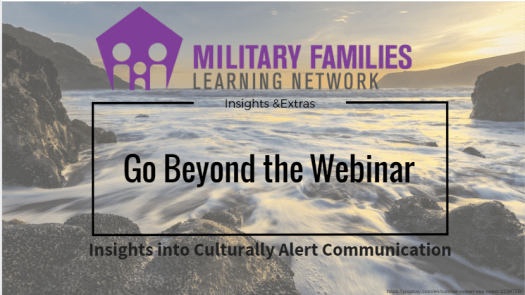By: Bari Sobelson

On Thursday, May 24, 2018, Dr. Tammi Dice and Mr. Tony Dice facilitated a webinar addressing culturally alert communication. Dr. Dice started us off with this insightful and thought-provoking statement: “Rather than striving for cultural competence, my aim is really to be culturally humble because there’s always room for growth and development.” Mr. Dice shared that one of the reasons he has taken an interest in the topic of culturally alert communication is because of some of the undergraduate and graduate diversity courses that “shook him to his core”, suddenly making him very aware of his unearned privileges that he has held his whole life.
How do we make sure we are being culturally sensitive with others?
By doing the following, we are capable of developing the skills to engage in culturally alert communication:
- Engage in self-awareness- This requires multiple layers of work.
- Be open to learning about others- It’s important to take the time to get to know our clients. Instead of just reading a book about their particular culture, ask them questions and appreciate that there are many individual variations within different cultures and the ways in which individuals experience them.
- Have an awareness of the broader social systems- Think about the influences that these systems have on our clients and their experiences.
Why does it matter?
All of this is done with intention. It is up to us, as providers, to begin to break down the walls that may come in the room with the client. It’s important to remember the following:
- As service providers, we have an ethical obligation to our clients
- We could potentially do harm, minimize the impact of our efforts, negate the work we are trying to do
- We could scar our clients in a way that would make them averse to further help and treatment
- Our clients could lose trust in the system
This is not an easy task!
Dr. Dice will often start her diversity courses with a Walt Whitman quote and ask her students to be open for perspective-taking and help them to recognize the need for empathy. While she doesn’t ask individuals to change their perspective, she does invite them to be open to recognizing that alternative views are just as legitimate. This allows multiple perspectives to be present and for us to be more effective because we aren’t then imposing our own views, beliefs, and values on our clients.
Inviting people to become culturally alert will often result in cognitive dissonance where new information and experiences create discomfort. It’s important to challenge yourself that perhaps your are experiencing discomfort because the information you are receiving is unfamiliar. Cognitive dissonance is a healthy and normal process that we engage in for growth and development. Attempt to practice skills until they are no longer uncomfortable for you.
Terms to Remember
Intersectionality: We are all made up of many dimensions and all of these intersecting cultural identities have a part, a space in the room. We need to always be aware that every relationship we encounter is diverse on some level. Barriers occur in intervention when we overemphasize one component of a person and fail to recognize others. It is important to continually look at our clients as multifaceted, intersecting individuals with multiple identities. Multiple intersecting, marginalized identities can create large challenges. By acknowledging the challenges of holding marginalized identities, we can begin to recognize the myth of meritocracy.
Myth of Meritocracy: The belief that all individuals have equal opportunities. Often when those of marginalized status struggle to achieve, then personal and cultural reasons are assumed to be responsible while the broader social barriers/inequity in society are either not considered or they are ignored. As a result, those individuals get judged by those who have privilege status as “not working hard enough:. Letting go of this myth can allow us to be more alert and aware of the systemic oppression that can occur for so many who identify with underrepresented populations and begin to avoid both unintentional and intentional discrimination.
Broaching: Inviting discussions about the differences that exist. Broaching helps to clarify how an individual identifies and communication norms and helps to establish authentic relationships. This does not come naturally but just because it isn’t easy or doesn’t feel comfortable doesn’t mean it’s not effective. It requires practice and the recognition of its benefits. How do we do it? Through asking questions, being sensitive, and responding in an empathetic manner! We store the information that we are given and use it to hep us build the relationship.
Learn More
While we have offered plenty of food-for-thought through this blog, we encourage you to delve deeper and learn more about this topic by watching Dr. and Mr. Dice’s webinar. They offer techniques and tools and so much more through this interactive and engaging programming. And, FREE CEUs are offered for one year from the live date of this webinar.
This post was written by Bari Sobelson, MS, LMFT, the Social Media and Programming Coordination Specialist for the OneOp Family Development Team. The Family Development team aims to support the development of professionals working with military families. Find out more about OneOp Family Development concentration on our website, Facebook, and Twitter.














